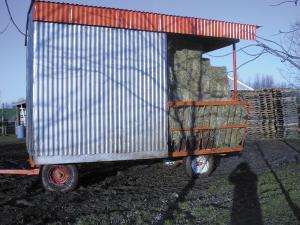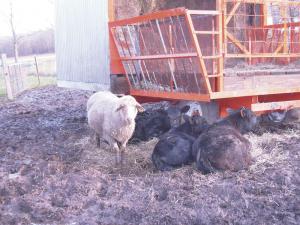Mobile Hay Feeder
Tired of feeding hay on wet ground, Gerard Driesel decided to build a new kind of hay feeder. He can back his mobile feeder into the barn, fill it and then park it in his barnyard until the hay is gone. Best of all, it holds up to 120 bales under roof for easy feeding with very little waste.
"We have a small farm and put up our own hay," says Driesel. "Using the hay wagon feeder saves two to three bales a week over feeding in a ground feeder. That can be enough to make the difference in having enough hay or having to buy hay."
Driesel's covered wagon feeder cost him nothing, other than about 50 hours labor. He was able to salvage some old 12-ft. 2 by 10-in. treated bleacher seats that were being replaced at a local college. While too splintery and worn for seating, they were fine for floor joists and flooring for the feeder.
"I set the best ones on end on 2-ft. centers, resting them on the steel channel beams of an old wagon with a rotted out bed," says Driesel. "The rest were nailed down as flooring. The steel channel beams were only 14 ft. long, so that's how long the bed became."
He built a wooden frame and trusses out of salvaged 2 by 4's. Steel roofing received when he helped clean up a farmstead became roof and siding for the hay wagon.
Hayracks are 6 ft. long and hang on each side of the rear 6 ft. of the wagon. The hayrack frames are sections of angle iron with the backside filled in with steel grating. The outward slanting side, which the cattle and sheep access, is a combination of 1-in., 3/4-in. and 1/2-in. pipe, whatever he had lying around.
"If I was using new material, I would go with 1/2-in. rod as it is sufficiently strong," explains Driesel.
The back end of the wagon is a gate constructed of angle iron framing and fence netting. When it's time to refill the wagon, Driesel simply backs into his barn, opens the gate and loads a fresh set of bales.
After two months of use, Driesel is well satisfied with his new feeder. He likes it well enough that he recommends it to others.
"I think a wagon like this would be ideal with horse owners or others who don't have hay storage on their place," he says. "If they built it on the frame of an old horse or livestock trailer, they could pull it to the farmer they buy hay from, pull it home and feed out of it until it was time for another load. You eliminate the need for a truck to haul with and a barn to store it in; yet the hay stays dry all the time."
Contact: FARM SHOW Followup, Gerard Driesel, 2612 Oregon Road, Lyndonville, N.Y. 14098 (ph 585 765-2280; gdriesel@rochester.rr.com).

Click here to download page story appeared in.
Click here to read entire issue
Mobile Hay Feeder LIVESTOCK Feeding Equipment 31-2-26 Tired of feeding hay on wet ground, Gerard Driesel decided to build a new kind of hay feeder. He can back his mobile feeder into the barn, fill it and then park it in his barnyard until the hay is gone. Best of all, it holds up to 120 bales under roof for easy feeding with very little waste.
"We have a small farm and put up our own hay," says Driesel. "Using the hay wagon feeder saves two to three bales a week over feeding in a ground feeder. That can be enough to make the difference in having enough hay or having to buy hay."
Driesel's covered wagon feeder cost him nothing, other than about 50 hours labor. He was able to salvage some old 12-ft. 2 by 10-in. treated bleacher seats that were being replaced at a local college. While too splintery and worn for seating, they were fine for floor joists and flooring for the feeder.
"I set the best ones on end on 2-ft. centers, resting them on the steel channel beams of an old wagon with a rotted out bed," says Driesel. "The rest were nailed down as flooring. The steel channel beams were only 14 ft. long, so that's how long the bed became."
He built a wooden frame and trusses out of salvaged 2 by 4's. Steel roofing received when he helped clean up a farmstead became roof and siding for the hay wagon.
Hayracks are 6 ft. long and hang on each side of the rear 6 ft. of the wagon. The hayrack frames are sections of angle iron with the backside filled in with steel grating. The outward slanting side, which the cattle and sheep access, is a combination of 1-in., 3/4-in. and 1/2-in. pipe, whatever he had lying around.
"If I was using new material, I would go with 1/2-in. rod as it is sufficiently strong," explains Driesel.
The back end of the wagon is a gate constructed of angle iron framing and fence netting. When it's time to refill the wagon, Driesel simply backs into his barn, opens the gate and loads a fresh set of bales.
After two months of use, Driesel is well satisfied with his new feeder. He likes it well enough that he recommends it to others.
"I think a wagon like this would be ideal with horse owners or others who don't have hay storage on their place," he says. "If they built it on the frame of an old horse or livestock trailer, they could pull it to the farmer they buy hay from, pull it home and feed out of it until it was time for another load. You eliminate the need for a truck to haul with and a barn to store it in; yet the hay stays dry all the time."
Contact: FARM SHOW Followup, Gerard Driesel, 2612 Oregon Road, Lyndonville, N.Y. 14098 (ph 585 765-2280; gdriesel@rochester.rr.com).
To read the rest of this story, download this issue below or click
here to register with your account number.








